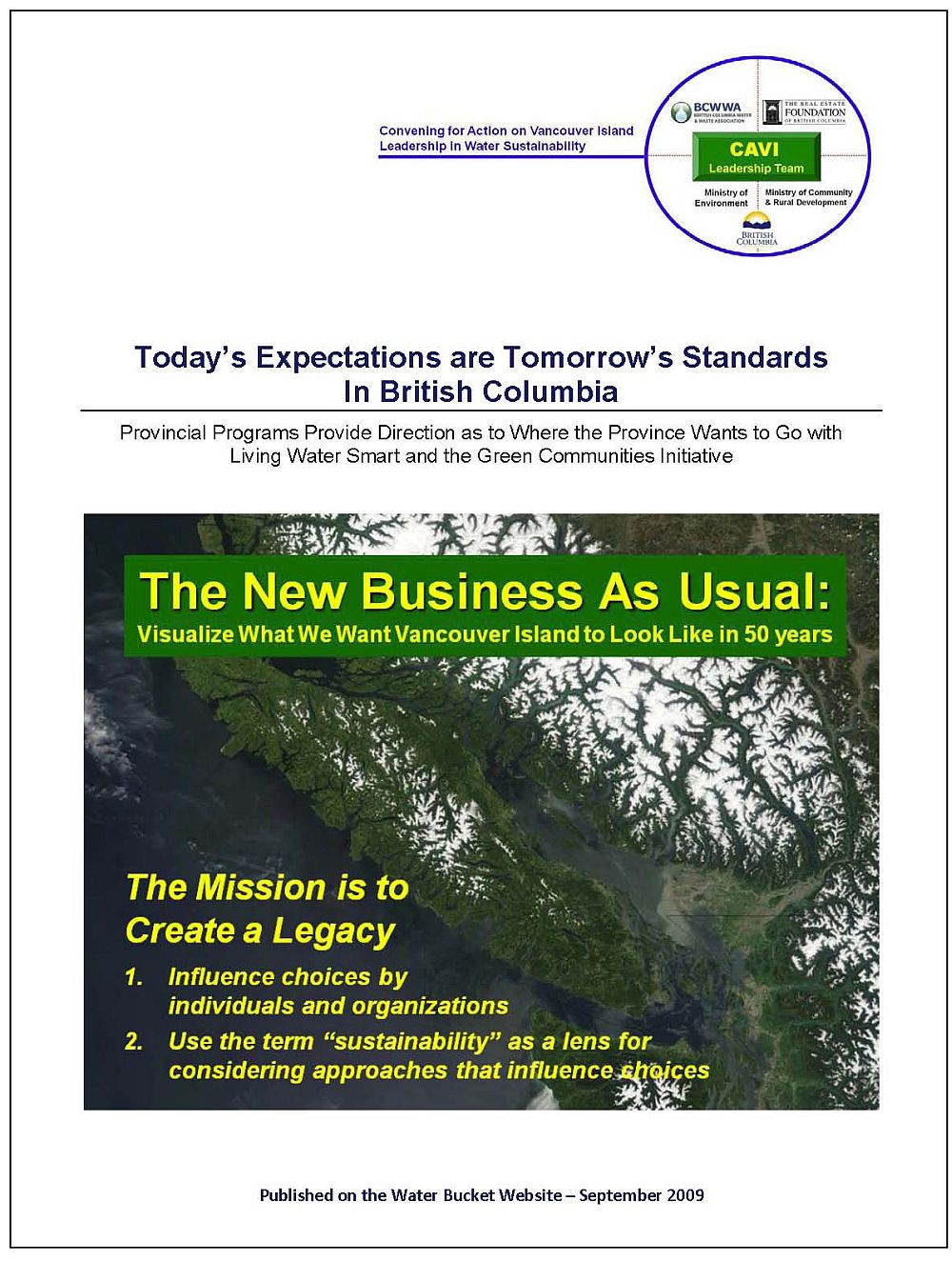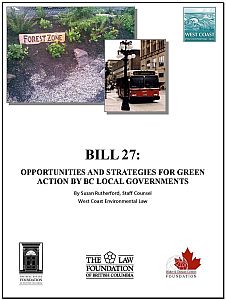GETTING AHEAD OF THE WAVE: “Today’s Expectations are Tomorrow’s Standards in British Columbia” – Story #7 in the ‘curriculum preview series’ for 2009 Comox Valley Learning Lunch Seminar Series elaborated on the direction provided by the provincial government’s Living Water Smart and Green Communities initiatives
Note to Readers:
This article is the seventh in a series that will both set the scene and serve as a resource for the 2009 Comox Valley Learning Lunch Seminar Series. This Story #7 is an abridged version of an article that is eleven pages in length. To read the complete article, click on this link to download a PDF version of Today’s Expectations are Tomorrowss Standards In British Columbia.
This abridged article describes the provincial context that provides a backdrop for the 2009 Series. The article summarizes complementary programs led by two ministries, namely:
- Living Water Smart, BC’s Water Plan, an across-government program led by the Water Stewardship Division of the Ministry of Environment
- Green Communities Initiative, led by the Ministry of Community and Rural Development
These two programs are mutually supportive and together establish clear expectations for local governments going forward. The full version of the article elaborates on the Today’s Expectations are Tomorrow’s Standards theme; it also introduces the Comox Valley Regional Growth Strategy in order to connect the dots so that readers will understand how the ‘regional team approach’ is being demonstrated in the Comox Valley.

Provincial programs provide direction as to where the Province wants to go with Living Water Smart and the Green Communities Initiative
“The program goals for Living Water Smart and Green Communities constitute a ‘call to action’ on the part of British Columbians to implement The New Business As Usual,” states Kim Stephens, Program Coordinator for the Water Sustainability Action Plan for British Columbia.
 “The Province has put in place a policy framework that enables local governments to be proactive in doing business differently: This is what we want our communities to look like in 50 years, and this is what we will do starting now to ensure it happens.”
“The Province has put in place a policy framework that enables local governments to be proactive in doing business differently: This is what we want our communities to look like in 50 years, and this is what we will do starting now to ensure it happens.”
“To help local governments move from awareness to action on the ground, the Province has also provided funding for web-based tools such as the Water Balance Model, Water Bucket Website, Irrigation Scheduling Calculator and Water Conservation Calculator.”
Alignment with Living Water Smart Vision
“ A key message in Living Water Smart is that green development makes sense,” emphasizes Lynn Kriwoken, Director of the Water Stewardship Division in the Ministry of Environment; and the Province’s lead person for development and delivery of Living Water Smart. It was Lynn Kriwoken’s inspiration plus her Ministry’s seed funding that brought the vision for the Water Sustainability Action Plan to fruition.
A key message in Living Water Smart is that green development makes sense,” emphasizes Lynn Kriwoken, Director of the Water Stewardship Division in the Ministry of Environment; and the Province’s lead person for development and delivery of Living Water Smart. It was Lynn Kriwoken’s inspiration plus her Ministry’s seed funding that brought the vision for the Water Sustainability Action Plan to fruition.
“New thinking about development leads to new benefits. These include more green spaces, more water and fish in the streams, improved community vitality, reduced demand for water, and reduced expenditure on infrastructure.”
Shared Responsibility:
“Water issues are complex and best solved collaboratively, which include using strategies and solutions that fall outside government control. While legislative reform is a foundation piece, collaboration takes place outside the legislative framework. At the end of the day, planners and engineers and other disciplines must come together to determine the issues and solutions. No statute will help them do that.”
“This is why we constantly emphasize that Living Water Smart is about motivating and inspiring everyone to embrace shared responsibility. Influencing behaviour and attitudes is at the heart of moving from awareness to action.”
Accelerating the Current Momentum
“In 2008, the pilot Vancouver Island Learning Lunch Seminar Series successfully demonstrated how to inform, educate and inspire local government practitioners about making ‘green choices’ to create liveable communities and protect stream health,” reports John Finnie, CAVI Chair (and General Manager, Water & Wastewater Services, Regional District of Nanaimo).
“As an outcome of the 2009 Series, we want to get people thinking about how to make real the 2020 objective of supplying 50% of new water demand by using less. Getting there requires going well beyond the usual indoor water saving measures. It entails accelerating the current momentum for changing what we do on and to the land.”
 Green Communities Initiative
Green Communities Initiative
In May 2008, the “Green Communities” legislation known as Bill 27 amended the Local Government Act and Community Charter. This legislation helps municipalities and regional districts create more compact, sustainable and greener communities.
Opportunities and Strategies for Green Action
 In June 2009, West Coast Environmental Law released a discussion paper titled Bill 27: Opportunities and Strategies for Green Action by BC Local Governments. Written by West Coast Staff Counsel, Susan Rutherford, the paper is designed to provide “…analysis and practical guidance regarding how local governments may use the legal tools available to advance green initiatives.” The focus is Bill 27, new powers extended under it, and how that power may be used to strengthen sustainability efforts.
In June 2009, West Coast Environmental Law released a discussion paper titled Bill 27: Opportunities and Strategies for Green Action by BC Local Governments. Written by West Coast Staff Counsel, Susan Rutherford, the paper is designed to provide “…analysis and practical guidance regarding how local governments may use the legal tools available to advance green initiatives.” The focus is Bill 27, new powers extended under it, and how that power may be used to strengthen sustainability efforts.
Achieving Green Action Objectives:
 The West Coast paper is organized by four Green Action topics:
The West Coast paper is organized by four Green Action topics:
- Global Warming Greenhouse Gas (GHG) and Energy Reduction;
- Climate Change Adaptation;
- Water Sustainability; and
- Sustainable Land Use.
Under each topic, the paper discusses New Requirements and New Opportunities, as well as Strategies for overcoming challenges and making the best use of the powers for achieving each of the Green Action objectives.
“The paper by Susan Rutherford discusses a variety of legal tools, including development permit area guidelines. This is especially relevant to the 2009 Comox Valley Series because the development permit tool has been identified as a means to advance the regional team approach,” notes Kim Stephens.
Provincial Funding Fosters Innovation and Integration
“A mandate of the Ministry of Community & Rural Development is to foster partnerships, collaboration, innovation and integration through the program elements that comprise the Green Communities Initiative,” states Glen Brown, Executive Director of the Local  Government Infrastructure and Finance Division of the Ministry.
Government Infrastructure and Finance Division of the Ministry.
“Ultimately it is the Ministry’s grant programs that provide the incentives that enable the Province to influence local government behaviour; and reward those who meet program objectives for doing business differently on-the-ground.”
“The reality of an increasing local government infrastructure deficit means that there will be even stiffer competition for available funding. As a result, there is a greater incentive for local governments to demonstrate how their innovation and integration will be effective in meeting the goals of both the Green Communities Initiative and Living Water Smart.”



